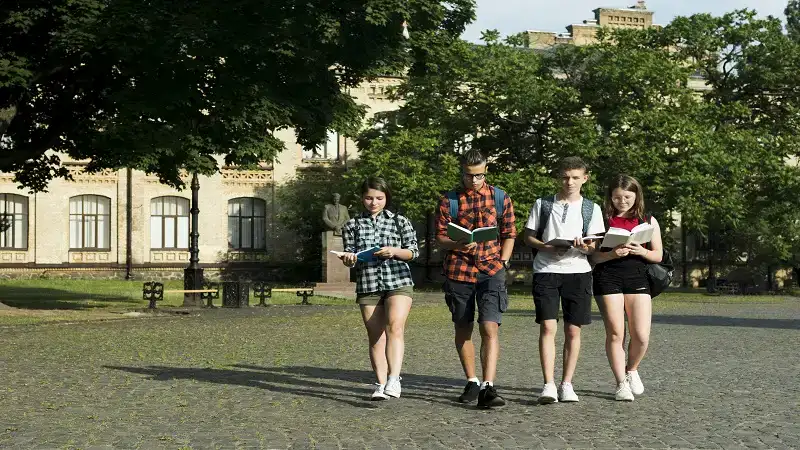Fashion has long been integral to student life, reflecting social changes and cultural movements. Student fashion has developed through time – from vibrant styles of the Roaring Twenties to more subdued looks on modern campuses – offering insight into influences shaping clothing choices and self-expression for today’s students.
Roaring Twenties: Flapper Fashion and Rebellion
The Roaring Twenties represented a cultural revolution, and student fashion emerged as an essential medium of expression. Young people buoyed by postwar optimism rebelled against Victorian restrictions; flapper fashion became a striking symbol of liberation as female students donned dropped waistlines, knee-length skirts, and loose-fitting dresses that defied modesty from previous decades, while iconic bobbed hairstyles and headbands signaled their departure from traditional femininity – this decade reflected carefree libertarian attitudes which coincided with society shifting towards freedoms and individualism;
Postwar Optimism in the 1950s: Preppy Styles and Collegiate Elegance
The 1950s brought postwar prosperity and a revival of traditional values, culminating in preppy styles becoming the epitome of collegiate elegance on campus. Male students donned button-down shirts, khakis, and varsity jackets; female students adopted full skirts, cardigans, and saddle shoes to project sophistication and grace; this polished aesthetic reflected society’s emphasis on conformity reflecting its desire for stability while at the same time reflecting traditional values.
The 1960s and 70s: Counterculture and Bohemian Vibes
In the 1960s and 70s, student fashion saw an abrupt change. Reflecting a more significant counterculture movement, students rejected established norms and adopted more distinctive and bolder styles found among hippie and bohemian cultures; tie-dyeing, bell bottoms and fringed maxi dresses became standard fare, signaling rejection of clean-cut types of the previous decade and marking an increasingly casual approach to clothing as an expressive platform to express anti-establishment sentiments and individualism.
1980s: Bold Statements and Preppy Revival
The 1980s was an era marked by bold statements and a revival of preppy styles with an extravagant edge. Neon colors, oversized silhouettes, and power suits reigned supreme; neons dominated the fashion scene, mirroring its decadence. Athleisure gained momentum, with tracksuits and sneakers becoming fashionable staples thanks to high-end designer influence and rising streetwear popularity. This period captured perfectly the juxtaposition of extravagance and casual comfort that characterized this period marked by excess
Grunge and Minimalism in the 90s: Casual Cool
The 1990s ushered in an era of casual coolness, marked by grunge fashion and minimalist aesthetics. Students adopted iconic elements like flannel shirts, Doc Marten boots, and ripped jeans in an anti-establishment, effortlessly cool style; simultaneously, minimalist fashion characterized by simple lines and neutral colors gained traction; casual coolness became a feature of student fashion during this decade, reflecting both an authentic desire to reject excesses of previous decades as well as rejection of lots from former years.
Individualism and Global Trends in the Digital Era
The digital revolution brought fashion democratization in the late 20th and 21st centuries. Students took full advantage of individualism to mix styles from various eras and cultures freely; fast fashion stores and online influencers hastened trend turnover, making campuses into melting pots of diverse styles with students freely expressing themselves through fashion choices influenced by global trends and subcultures – reflecting an ever-evolving landscape. Digital era introduced us with a lot of diverse and memorable character designs, including video games. Learn how video games reduce stress.
Braces are also a trend in this era. Students, irrespective of gender, like to use braces to ensure better tooth positioning.
Sustainability and Conscience Fashion.
Recent years have witnessed an escalation of awareness surrounding sustainability and ethical practices that have altered student fashion. Socially aware students favor vintage and sustainable clothing as forms of protest; thrift finds, upcycled clothes and eco-friendly brands have become integral elements of modern student fashion, signaling a significant shift toward responsible consumption and environmental responsibility.
Gender Fluidity and Inclusivity
Contemporary student fashion is witnessing an exciting evolution towards gender fluidity and inclusivity. Traditional gender norms are being challenged as students embrace androgynous styles and non-binary identities to express themselves without conforming to conventional gender expectations. Campus fashion landscape has also evolved significantly as more students celebrate unique expressions of identity rather than conforming to outdated gender norms – reflecting society’s broader shift toward acceptance, diversity, and celebrating individualism. This evolving mindset echoes this broader shift.
Globalization and cultural integration
Globalization’s influence on student fashion cannot be overstated. Our increasingly interconnected world has brought an explosion of styles from around the globe into daily campus wear. Social media and online platforms expose students to international fashion trends from every culture; students then incorporate elements from these into their fashion choices through social media posts or other means; this global exchange adds vibrancy and fosters understanding and appreciation of cultural diversity.
Tech-Infused Fashion Trends to Keep Up With
At present, technology is becoming an essential element of student fashion. Once a utopian vision, wearable tech has become an everyday reality, changing its aesthetics and functionality. Students now incorporate smartwatches, fitness trackers, and other tech-infused accessories into their outfits; wearable tech such as fitness trackers can even charge phones through solar panels! You can even get essay help online. Students’ innovative approaches to clothing reflect how students have adjusted to a constantly shifting landscape where fashion serves not just self-expression but also cutting-edge innovations that drive cutting-edge innovations forward.
As student fashion reflects broader societal shifts, cultural transformations, and individual expression, its development over time reflects changes to society, culture, and self-expression. From rebellious flapper styles of the Roaring Twenties to gender-inclusive, sustainable fashion on modern campuses – student attire continues to serve as both canvases for creative expression and a mirror of times. Fashion’s cyclical nature ensures past trends reemerge with a contemporary edge, highlighting student fashion’s everlasting nature and ever-evolving over time.
